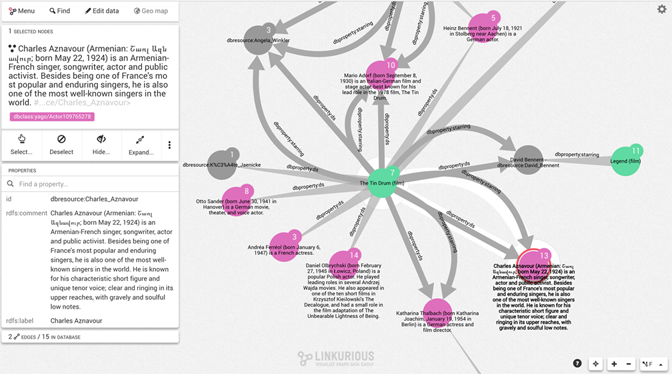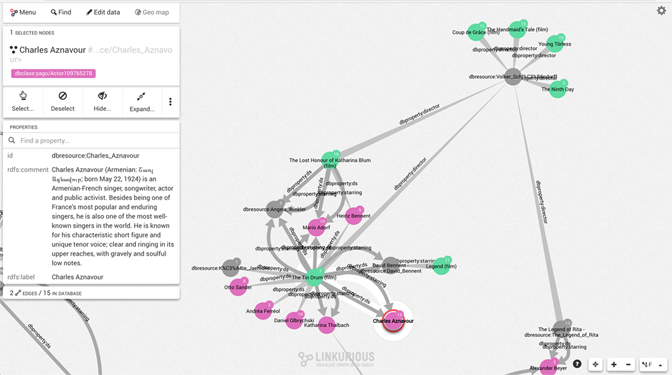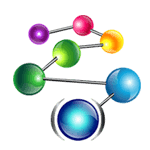
- 15 October, 2016
AllegroGraph News – October, 2016
In this issue
- AllegroGraph 6.1 Now Available
- Gruff v6.3 Now Available – Browser Capabilities
- Linkurious plus AllegroGraph
- Franz CEO, Jans Aasman to Present at the Knowledge Management World Conference (KMWorld 2016) in Washington D.C. – November 16th
- Recent Articles about Franz – AllegroGraph
- Join us at Smart Data, Jan. 2017
- Join us at Semantic Technology for Intelligence, Defense, and Security (STIDS), Nov. 15th.
- Brief Customer and News Highlights
AllegroGraph 6.1 Now Available


New Features Include:
|
For additional information, see here
Gruff v6.3 Now Available – Browser Capabilities
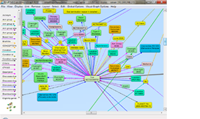

New Features Include:
- This release features a preliminary version of Gruff support in web browsers, where any web browser can connect to Gruff and display its graph view. A menu bar containing a subset of the graph view commands allows browsing the database directly in the web browser. We would be interested to hear if you find this useful. To try it out, start up Gruff as usual and open a database, then use “Global Options | Communications | Start HTTP Server”. Let’s say that Gruff is running on a machine named hazel and you start its HTTP server on port 8008. You can then go to any web browser that can reach hazel and tell it to visit hazel:8008. The web browser should then display roughly the same thing as Gruff. You can then explore the commands that are on the menu bar in the web browser. Currently you must open a database in Gruff itself because the web browser interface does not yet have a command for selecting a store to open. This has mostly been tested on Firefox and Chrome so far.
- The new option “Visual Graph Options | Tooltips | Highlight Links of Node Under Mouse” will highlight the links between the node that’s under the mouse and its linked nodes. In a tree layout, it will highlight the entire paths between the node under the mouse and the root node as well as all of the node’s descendants. This option is on by default. The delay before showing the highlighting can be set with the new option “Visual Graph Options | Tooltips | Highlighted Links Delay”.
- When “Text Search | Search the Current View” is used in the graph view, table view, or query view, the actual search text is now highlighted within the node or table cell, rather than highlighting only the whole node or cell. This aids spotting matches in long literals. This could be turned off with the new option “Visual Graph Options | Node Labels | Highlight Search Text in Nodes”.
- The new graphical query view right-click background pop-up menu commands “Convert Highlighted to Variable Nodes” and “Convert Highlighted to Variables with Types” allow converting multiple non-variable nodes to variables at once (after you highlight them by control-clicking each one).
- Non-variable nodes in the graphical query view now use the same background colors as in the graph view to indicate their types, rather than using the same color for all non-variable nodes.
- Fixed: When using “Graphical Query Non-Variable Node | Convert to Variable with Types” on a node that has no types, the variable node was given a filter that matches a variable to a type of that node, which typically would cause the query to have no solutions.
- In various commands that require a selected node to act on, if there is no selected node then the command will now first let you select a recently-selected node to reselect and then act on.
- When connecting to a SPARQL endpoint, Gruff will now know what named graph each triple is in and display it in the table view. Gruff will also work properly with an endpoint that does not include triples from named graphs in the default dataset for a query that does not use FROM or FROM NAMED clauses.
- Fixed: Doing a tree layout when there are reification link lines could get into an infinite loop.
- Fixed: Saving a query in the query view would break if the query contains “from” clauses.
- Layouts can now be done in the graphical query view.
- The new option “Global Options | Communications | Use Digest Authentication” causes communication with a SPARQL endpoint that requires a username and password to use the more secure “digest access authentication” (rather than basic). It’s on by default, but could be turned off if a server doesn’t support it. And previosly connecting to a SPARQL endpoint that requires authentication often did not work at all.
- The new option “Global Options | Communications | Warn on Version Mismatch” shows a warning dialog if you open a database on an AllegroGraph server whose version does not match the version of the lisp client on which Gruff is built, because things will likely not work. It is on by default, but could be turned off to avoid the nuisance if a small version mismatch happens to work.
- Fixed: The warning dialog for “Visual Graph Options | Inclusion Options | Number of Links from One Node for Warning” was sometimes issued when it shouldn’t be because it was counting nodes that had been shown linked to the selected node, but then removed from the display later.
- Fixed: Editing a node could break in a store that contains rdfs:domain and/or rdf:range triples in it, where objects of those triples have superclasses.
For additional information, see the Gruff Documentation


Linkurious is an Enterprise class tool for visualizing graph data. Linkurious is a partner of the International Investigative Journalist Consortium (ICIJ) since the Swiss Leaks scandal. ICIJ network of 370 journalists is using Linkurious to investigate the Panama Papers. Integration with AllegroGraph is currently available for testing. The following images are of Linkurious screenshots displaying graph data stored in AllegroGraph. (Click on image to enlarge).
For additional information, please contact Linkurious
Franz CEO, Jans Aasman to Present at the Knowledge Management World Conference (KMWorld 2016) in Washington D.C. – November 16th


The topic of the talk – Tools for Expanding KM Processes. In this high-speed digital era, organizations have to deal with high volumes of structured and unstructured data. New digital tools are being developed to help analyze and visualize this vast amount of data; however, many challenges still remain. Jans will discuss how graphs and KM have gained significant visibility with the rebirth of artificial intelligence and the emergence of cognitive computing. He discusses recent collaborations with Montefiore Health System, Intel, Cloudera, and Cisco to improve a patient’s knowledge around the probabilities of their future health status. The knowledge creation stems from the capability to combine the probability space (statistical patient data) with a knowledgebase of comprehensive medical codes and a unified terminology system. The confluence knowledge via machine learning, semantics, visual querying, graph databases, and Big Data not only displays links between objects, but also quantifies the probability of their occurrence.
Recent Articles about Franz – AllegroGraph
  |
|
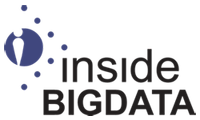  |
|
  |
|
  |
|
  |
|
  |
|
Join us at Smart Data, Jan. 2017


The Smart Data Conference is designed to accommodate all levels of technical understanding. It will bring together emerging disciplines that are focused on more intelligent information gathering and analysis. Franz CEO Jans Aasman will be participating as one of the featured speakers. The conference will be held at the Sofitel San Francisco Bay hotel in Redwood City – January 31 – February 1. Please join us.
To learn more about the conference and to register, see here.
Join us at Semantic Technology for Intelligence, Defense, and Security (STIDS), Nov. 15th.


The 11th International Conference on Semantic Technology for Intelligence, Defense, and Security (STIDS 2016) will be held in November of 2016 at the George Mason University Fairfax, Virginia Campus. STIDS provides a forum for academia, government and industry to share the latest research on semantic technology for defense, intelligence and security applications. Semantic technology is a fundamental enabler to achieve greater flexibility, precision, timeliness and automation of analysis and response to rapidly evolving threats.
Franz will be conducting a tutorial at this conference. During the tutorial we will touch on other visualization tools, such as Linkurious and Gephi, and how they can be used to view the overall structure in your data. We will touch on ideas to use these tools collaboratively with Gruff and best practices for exploring large RDF datasets. Please join us.
To learn more about the conference and to register, see here.
Brief Customer and News Highlights
|
|
We are Hiring! |
|
|
2015 HiMSS Conference, Intel’s Healthcare Panel, Parsa Mirhaji, MD, PhD, the Director of Clinical Research Informatics at the Montefiore Medical Center discusses their Semantic Data Lake and technical partnerships with Intel and Franz Inc. and Intel – Cisco presenting Franz’s Semantic Data Lake Analytics at HIMSS 2015 |
| Bloor Research Positions AllegroGraph as a “Champion”. Click on the image to enlarge. | |
|
|
Franz was named as one of 21 NoSQL Innovators to Look for in 2020, in a post on The Wikibon technology research and advisory website because of its flagship RDF and Graph Database product, AllegroGraph. |
  |
Graph databases, like AllegroGraph, are one of the new technologies encouraging a rapid re-thinking of the analytics landscape. By tracking relationships – in a network of people, organizations, events and data – and applying reasoning (inference) to the data and connections, powerful new answers and insights are enabled…
Wolters Kluwer Presentation: “How does Linked Open Data change the Publishing Landscape?” |
|
|
Recorded Webcast – Haystax presents: Advanced Analytic Techniques for Insider Threat Detection |
|
|
The Malaysian State of Sabah’s Biodiversity Center’s (SaBC) is using AllegroGraph to run the Sabah Biodiversity Integrated Information System (SaBIIS) AllegroGraph is the centralized RDF database used to integrate and store biodiversity data coming from more than 20 organizations that collect specimen data in different formats and schemas.
Read the press release here. |
|
|
KRSTE.my (Knowledge Resource for Science and Technology Excellence, Malaysia) is an initiative, based on AllegroGraph, by MOSTI and spearheaded by MASTIC to address science and technology issues and challenges faced by the community, the ministry and the country. KRSTE.my is designed to be a Single Point Access Facilities (SPAF) providing intelligent collaborative knowledge management and learning services platform on Science and Technology and Innovation. More info here. |
|
|
Information Management article – Why Data Lakes Require Semantics |
|
|
Inside Analysis article – Events that Change the World |
|
|
Datanami article – Multi-Dimensional Graph Data Opens the Door to New Applications |
|
|
Datanami article – Hadoop, Triple Stores, and the Semantic Data Lake |
Recorded past Semantic Technologies Webinars: Recorded Webinars






